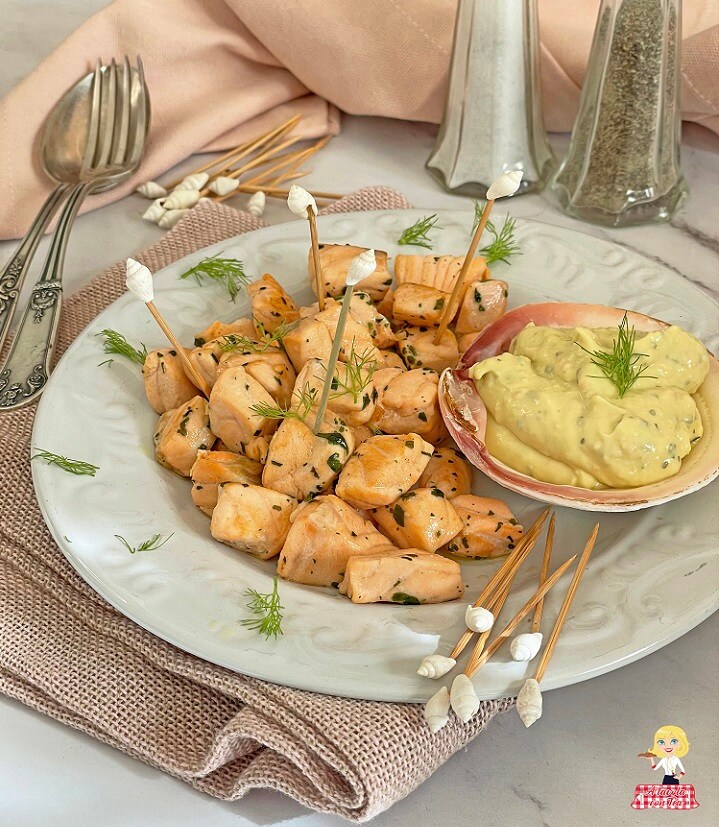The Pan-Seared Salmon is a delicious yet light fish dish that’s truly easy to prepare and suitable for any occasion: whether it’s a quick lunch paired with a fresh salad or a family dinner with a side of boiled potatoes, it will always be a guarantee of success.
Today’s recipe for Pan-Seared Salmon Bites is super quick to prepare, and the brief pan-cooking with a few aromatics enhances its delicate flavor and the tenderness of the meat, allowing you to serve a soft and juicy dish.
Preparing this recipe for Pan-Seared Salmon Bites is very easy: just prepare a simple marinade with oil, lemon, parsley, and garlic, wait for the salmon to absorb the flavor, and then cook it in a pan for a very short time. Only this way can you be sure to get a dish with a unique aroma and tender, juicy meat.
Use either Salmon Bites, a whole fillet, or slices; only the cooking times will change.
If you want to make the dish even more flavorful, you can add tomatoes, capers, and olives during cooking—a combination of flavors that brings vibrancy to the dish
Prepare the Salmon Bites in a pan, a truly easy recipe, perfect for any occasion, an excellent dinner saver, tasty and nutritious.
Let’s not forget that salmon, besides its unique flavor, is also rich in nutrients: it is a fish rich in “good fats” beneficial for the cardiovascular system.
For more salmon-based recipes, you can try

- Difficulty: Very easy
- Cost: Medium
- Preparation time: 10 Minutes
- Cooking methods: Stovetop
- Cuisine: Italian
- Energy 175.80 (Kcal)
- Carbohydrates 1.80 (g) of which sugars 0.35 (g)
- Proteins 6.15 (g)
- Fat 13.00 (g) of which saturated 2.40 (g)of which unsaturated 2.83 (g)
- Fibers 0.15 (g)
- Sodium 117.02 (mg)
Indicative values for a portion of 160 g processed in an automated way starting from the nutritional information available on the CREA* and FoodData Central** databases. It is not food and / or nutritional advice.
* CREATES Food and Nutrition Research Center: https://www.crea.gov.it/alimenti-e-nutrizione https://www.alimentinutrizione.it ** U.S. Department of Agriculture, Agricultural Research Service. FoodData Central, 2019. https://fdc.nal.usda.gov
Ingredients
- 4 fillets salmon (fresh, about 5.3 oz each)
- 3 tablespoons extra virgin olive oil
- 1 clove garlic
- 200 ml dry white wine
- 1 tablespoon chopped parsley
- to taste salt
- 1 pinch black pepper (ground)
Tools
- Pan
METHOD
NOTE
If you haven’t already had the salmon filleted by the fishmonger, proceed as follows: rinse the salmon fillets, remove the skin with a sharp knife, and check for any remaining bones by touching them with your fingertips; if present, remove them with kitchen tweezers. Dry it and then cut it first into strips and then into cubes about 0.6 inches each, as evenly as possible so that the cooking is uniform.
First, prepare the marinade: finely chop the parsley, grate the lemon zest separately (it must be organic). Pour the lemon juice into a bowl, add 2 heaping tablespoons of extra virgin olive oil and a crushed garlic clove. Mix with a spoon, then add the parsley, a pinch of pepper, and lemon zest, and mix again until you get an emulsion.
Transfer the salmon cubes into a bowl, add the marinade, cover with plastic wrap, and let it rest in the fridge to marinate for about an hour.
Meanwhile, prepare the TARTAR SAUCE, which you will need as an accompaniment.
After the resting time, take a large pan and put 2 tablespoons of extra virgin olive oil (about 0.8 oz), heat it, then add the salmon cubes drained from the marinade. Don’t discard the marinade! Cook the salmon over medium-high heat for about 3 minutes, turning them gently to avoid breaking.
At this point, increase the heat and deglaze with the white wine. Finally, pour the reserved marinade and cook for another 3 minutes. Adjust the salt and serve accompanied with the TARTAR SAUCE or, if you prefer, simply with the cooking juices poured over.

NOTES
To make the recipe even more flavorful, you can add capers, black olives, or cherry tomatoes halved during cooking.
I recommend not overcooking the salmon, as it might become dry and tough.
The marinade can also be made with another type of citrus, for example, lime or orange.
You can replace parsley with chives.
STORAGE
Once cooked, the salmon can be stored in the fridge for up to one day, in a food container.
FAQ (Frequently Asked Questions)
How to tell if the salmon in the pan is cooked?
To tell if the pan-seared salmon is cooked, it’s very easy because the internal color changes and becomes paler.
What to use to flavor the salmon?
To flavor the salmon, you can use in the marinade: lemon, orange, chives, lime, black pepper, or pink pepper.
What side dish goes with salmon?
Choose a simple side dish to accompany the salmon so as not to overpower the taste and balance of the dish: ideally, boiled potatoes seasoned with oil, salt, and chopped parsley, or a mixed salad.
How to tell if the salmon is fresh? How to choose the best fish?
To choose a good fresh salmon or to know if any fish is fresh, the rules are common.
It should have a good “sea” smell; if the fish is not fresh, it smells bad.
The scales should be intact and shiny, and the fins should not be brown.
The flesh should be firm and elastic to the touch.

